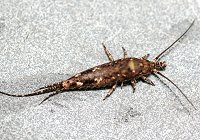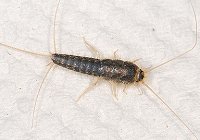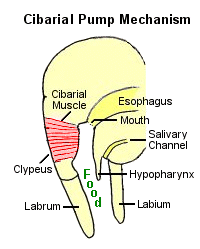Apterygote Insects
 The insects probably evolved from some primitive member of the superclass Crustacea during the Silurian period (400-440 million years ago). At this time in geological history, vascular plants were just beginning to evolve and invade the dry land. These plants undoubtedly represented a new and largely unexploited source of both food and shelter, and it is apparent from the early fossil record that insects were quick to take advantage of this new resource. Their newfound success in these harsh, terrestrial environments was certainly due, in part, to an exoskeleton with an outer layer of wax to minimize desiccation.
The insects probably evolved from some primitive member of the superclass Crustacea during the Silurian period (400-440 million years ago). At this time in geological history, vascular plants were just beginning to evolve and invade the dry land. These plants undoubtedly represented a new and largely unexploited source of both food and shelter, and it is apparent from the early fossil record that insects were quick to take advantage of this new resource. Their newfound success in these harsh, terrestrial environments was certainly due, in part, to an exoskeleton with an outer layer of wax to minimize desiccation.
Although there are no fossil remains of the first insects, it is reasonable to speculate from structures of the head and mouthparts that insects evolved independently from other hexapods. As mentioned previously, all primitive insects have ectognathous mouthparts (mandibles and maxillae not enclosed within a head cavity). These mouthparts are generally directed downward from the ventral side of the head (hypognathous) rather than forward from the front of the head (prognathous) as in other hexapods. Insects also evolved with an additional sclerite (the clypeus) on the anterior surface of the head capsule. Muscles extend from the clypeus to the upper walls of a pre-oral cavity (the cibarium) behind the mouthparts. When these muscles contract, the cibarium enlarges (like opening a bellows) and sucks food toward the mouth.
All insects are epimorphic (the number of body segments does not change over time). The primitive body plan includes a head, a three-segmented thorax, and an eleven-segmented abdomen. Paired abdominal appendages (slender styles or short pegs) can be found in only the most primitive insects. These appendages are probably remnants of crustacean legs. The external opening of an insect’s reproductive system, the gonopore, never occurs on the last abdominal segment (as in other hexapods). In male insects, the gonopore is located on the ventral surface of the ninth abdominal segment. In females, it is usually on or behind the eighth abdominal segment.
Insects are also characterized by a distinctive antennal structure (absence of muscles beyond the two basal segments), a wax layer covering the exoskeleton, and a complete respiratory (tracheal) system with external valves (spiracles) that can be opened to allow gas exchange or closed to prevent desiccation.
The earliest fossil insects are found in Devonian rock. They are strikingly similar to insects that we recognize today as bristletails. These “most primitive” of all insects are members of the subclass apterygota (from the Greek “a-” meaning without and “pterygo” meaning wing). They are completely wingless and have ametabolous development. In the past, entomologists grouped all primitive apterygote insects into a single order (Thysanura). More recently, however, the trend has been to divide this subclass into three orders: Archaeognatha, Thysanura, and Monura. Of these, only Archaeognatha and Thysanura have survived to the present time.
These apterygote orders share several “primitive” characteristics with crustaceans and non-insect hexapods. First, they continue to molt even as adults. Some Thysanura, for example, may live for several years and molt 40-50 times. Second, apterygote insects have short, segmented appendages along the sides of the abdomen. These structures appear to be homologous with abdominal appendages of crustaceans. And third, males produce spermatophores that are laid on the ground and later picked up by the female (external fertilization). Some species have developed elaborate courtship rituals that insure rapid and efficient exchange of the spermatophore.
Archaeognatha
 The order Archaeognatha (sometimes called Microcoryphia) includes insects commonly known as jumping bristletails. The members of this order are distinctive because their mandibles connect with the head capsule in only one place (monocondylic). This single point of articulation allows an auger-like vertical movement of the mandibles that is effective for removing lichens and algae from the substrate. Monocondylic mandibles are regarded as an “ancestral” characteristic (pleisiomorphic condition) because the mandibles of all other insects, Thysanura included, have two points of articulation with the head (dicondylic). Other ancestral features of Archaeognatha include external fertilization, claws on the maxillary palps, segmented abdominal stylets, and a ring-like segment (subcoxa) at the base of each leg.
The order Archaeognatha (sometimes called Microcoryphia) includes insects commonly known as jumping bristletails. The members of this order are distinctive because their mandibles connect with the head capsule in only one place (monocondylic). This single point of articulation allows an auger-like vertical movement of the mandibles that is effective for removing lichens and algae from the substrate. Monocondylic mandibles are regarded as an “ancestral” characteristic (pleisiomorphic condition) because the mandibles of all other insects, Thysanura included, have two points of articulation with the head (dicondylic). Other ancestral features of Archaeognatha include external fertilization, claws on the maxillary palps, segmented abdominal stylets, and a ring-like segment (subcoxa) at the base of each leg.
Most bristletails live in grassy or wooded habitats where they are most likely to be found in leaf litter, under bark, among stones, or near the upper tidal line in coastal areas. They are most active at night, feeding as herbivores or scavengers on algae, mosses, lichens, or decaying organic matter.
Sexual maturity is reached after at least eight juvenile instars spanning up to two years. Molting continues periodically even after adulthood. The sexes are separate, but copulation does not occur.
Males produce a packet of sperm (spermatophore) and leave it where a female More about
Archeognatha is likely to find it. Females cannot store sperm (they lack a spermatheca), and evidently acquire a new spermatophore before each bout of egg laying. Eggs are laid singly or in small groups (< 30). Some species have elaborate courtship rituals to insure that females are able to locate a spermatophore.
Zygentoma
 The order Zygentoma (formerly called Thysanura) includes the insects commonly known as silverfish and firebrats. Fossils of this order first appear in rock from the early Carboniferous period. Features of the head and mouthparts are more specialized than those of Archaeognatha. Dicondylic mandibles move only in a transverse direction allowing food to be ground between them on the molar surface.
The order Zygentoma (formerly called Thysanura) includes the insects commonly known as silverfish and firebrats. Fossils of this order first appear in rock from the early Carboniferous period. Features of the head and mouthparts are more specialized than those of Archaeognatha. Dicondylic mandibles move only in a transverse direction allowing food to be ground between them on the molar surface.
Silverfish are fast-running insects that hide under stones or leaves during the day and emerge after dark to search for food. A few species are resistant to desiccation and well-adapted to survive in domestic environments such as basements and attics. Silverfish are scavengers or browsers. They survive on a wide range of food, but seem to prefer a diet of algae, lichens, or starchy vegetable matter.
Zygentomans may be rather long-lived — three years is probably typical and up to seven or eight years may be possible. They continue to molt frequently, even after reaching adulthood.
Silverfish have an elaborate courtship ritual to insure exchange of sperm. More about
Zygentoma The male spins a silken thread between the substrate and a vertical object. He deposits a sperm packet (spermatophore) beneath this thread and then coaxes a female to walk under the thread. When her cerci contact the silk thread, she picks up the spermatophore with her genital opening. Sperm are released into her reproductive system, and then she ejects the empty spermatophore and eats it.


